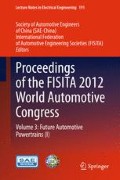Abstract
The fuzzy logic inference system was developed to identify driving intention. The membership functions and rules of the fuzzy logic inference system were built by using mathematical statistics and neural network. The vehicle model was built based on a series–parallel hybrid vehicle using Cruise software. The driving intention inference system was designed in Simulink. The simulation is done based on Cruise and Simulink. The simulation results prove that the fuzzy inference system can identify driving intentions excellently and the control strategy based on driving intentions can help to reduce more fuel consumption.
F2012-B02-015
Access this chapter
Tax calculation will be finalised at checkout
Purchases are for personal use only
References
Miller JM (2006) Hybrid electric vehicle propulsion system architectures of the e-CVT type. IEEE Trans Power Electron 21:756–767
Chan CC (2007) The state of the art of electric, hybrid, and fuel cell vehicles. Proc IEEE 95(4):704–718
Ehsani M, Gao Y. Miller JM (2007) Hybrid electric vehicles: architecture and motor drives. Proc IEEE 95(4)
Jalil N, Kheir NA, Salman M (1997) A rule-based energy management strategy for a series hybrid vehicle. In: Proceedings of the American Control Conference, vol 1. Albuquerque, NM, pp 689–693
Schouten NJ, Salman M, Kheir N (2002) Fuzzy logic control for parallel hybrid vehicles. IEEE Trans Cont Syst Technol 10(3):460–468
Won J-S, Langari R (2002) Fuzzy torque distribution control for a parallel hybrid vehicle. Expert Syst 19(1):4–10
Delprat S, Guerra TM, Rimaux J (2002) Control strategies for hybrid vehicles: optimal control. In: Proceedings, vehicular technology Conference (VTC 2002-Fall), vol 3. Vancouver, Canada, pp 1681–1685
Brahma A, Guezennec Y, Rizzoni G (2000) Optimal energy management in series hybrid electric vehicles. In: Proceedings of the American control conference, Chicago, IL, pp 60–64
Johnson VH, Wipke KB, Rausen DJ (2001) HEV control strategy for real-time optimization of fuel economy and emissions. SAE Paper No. 2001-01-1543
Jeon S-I, Jo S-T, Park Y-I, Lee J-M (2002) Multimode driving control of a parallel hybrid electric vehicle using driving pattern recognition. J Dyn Syst Meas Contr 124:141–149
Lin C–C, Filipi Z, Louca L, Peng H, Assanis D, Stein J (2004) Modelling and control of a medium-duty hybrid electric truck. Int J Veh Des 11(3/4):349–370
Zhu Y, Chen Y, Wu Z (2006) Optimization design of an energy management strategy for hybrid vehicles. Int J Altern Propul 1(12):47–62
Driankov D, Hellendoom H, Reinfrank M (1993) An introduction to fuzzy control. Springer, Berlin
Kono H (1998) Fuzzy control for hybrid electric vehicles. Master’s Thesis, Department of Electrical Engineering, The Ohio State University
Author information
Authors and Affiliations
Corresponding author
Editor information
Editors and Affiliations
Rights and permissions
Copyright information
© 2013 Springer-Verlag Berlin Heidelberg
About this paper
Cite this paper
Wang, Q., Tang, X., Sun, L. (2013). Driving Intention Identification Method for Hybrid Vehicles Based on Fuzzy Logic Inference. In: Proceedings of the FISITA 2012 World Automotive Congress. Lecture Notes in Electrical Engineering, vol 191. Springer, Berlin, Heidelberg. https://doi.org/10.1007/978-3-642-33777-2_22
Download citation
DOI: https://doi.org/10.1007/978-3-642-33777-2_22
Published:
Publisher Name: Springer, Berlin, Heidelberg
Print ISBN: 978-3-642-33776-5
Online ISBN: 978-3-642-33777-2
eBook Packages: EngineeringEngineering (R0)

